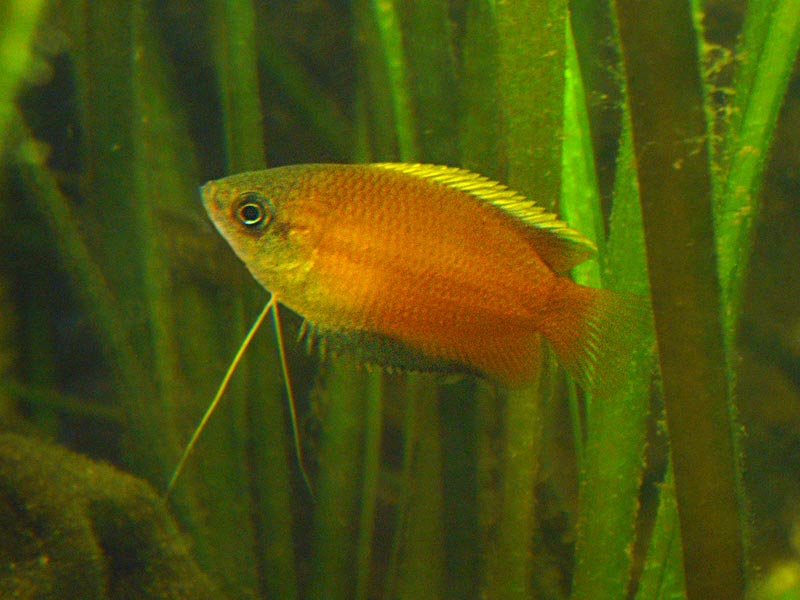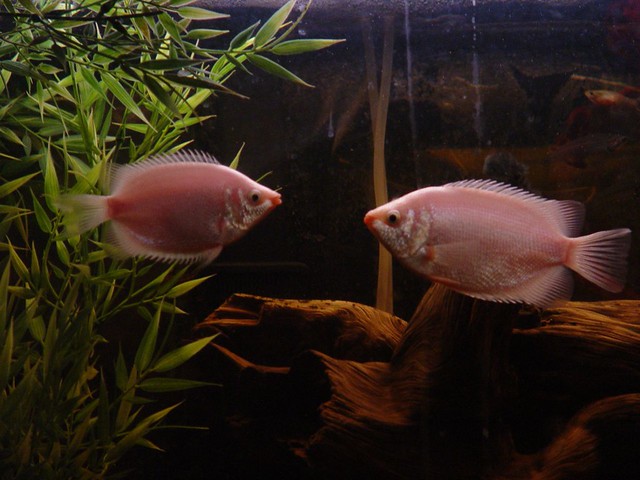 |
| Colisa Lalia bubble nest Category: Gourami images (Photo credit: Wikipedia) |
The male Dwarf Gouramis of all the colour variations are brightly coloured, while the females of most colour variations are relatively drab in appearance. However, the Coral Blue Dwarf Gourami is an exception to this in that the Female is also a beautiful Coral Blue colour and is scarcely inferior in colour to the male. The one thing common to all the colour variations is that the males all have some red on them while the females have almost no red.
Breeding
It is extremely unlikely that the dwarf Gouramis will succeed in breeding and raising babies with other fish in the tank. So you need to set up a tank specifically for their breeding. Some people have succeeded with tanks as small as 20 Litres (5 US Gallons), but I prefer a tank of at least 50 litres (13 US gallons).
The temperature should be about 27 degrees C (81 degrees F), and the pH neutral or slightly acidic. The hardness should be no higher than 10 dH. Normally the water level is lowered to about 20 centimetres (8 inches). Although I certainly recommend doing this, I have also succeeded in breeding this fish with much deeper water.
The breeding tank should be very well planted with a variety of types of plant, and including some floating ones.
You should only have one male present, but he can handle more than one female.
Nest
The Dwarf Gourami is a bubble nest builder. Unlike most of the Gouramis, the male usually incorporates some floating plants into their nest. As well as actual whole floating plants he may also incorporate bits of plants that he has broken off and chewed. The nest is relatively large compared with the size of the fish as well as being more elaborate than that of most gouramis.
Spawning
The male will entice a female under the nest. They may have a few trial matings. The male wraps his body around the female, turning her on her side or upside down and he releases his sperm at the same time as she releases her eggs. Any eggs that do not float up into the nest the male will pick up with his mouth and put into the nest. One female can lay up to 800 eggs.
After spawning with one female, the male will entice another one under the nest and this can continue until he runs out of females ready to breed. The total spawning procedure can take several hours. After spawning the male will add another layer of bubbles to the underside of the nest. He will defend his nest and the eggs. The females will need to be removed without disrupting the nest.
Raising the Fry
The eggs should hatch in 12-24 hours, and the fry should be free swimming in about 3 days. It is safer for the male to be removed once the fry is free-swimming.
Dwarf Gourami fry is very small. Some people cannot even see them with the naked eye, so babies will need microscopic food for some time. Often the first food to be given to them is green water. This is water with so many free-swimming algae that it looks green. The babies will grow and be able to eat bigger microscopic food, generally referred to as infusoria. After a while, they will be able to graduate to bigger food like newly hatched brine shrimp and screened Daphnia.
Live food is best for the babies, but this can be supplemented with commercial fry foods.
Filtering
A filter is necessary, but a normal power filter would suck up many of the babies. People have different ways of solving this problem. Some people put a thin cloth over the water inlet of the filter to stop the fry being sucked in. My preferred solution is to use a sponge filter.














